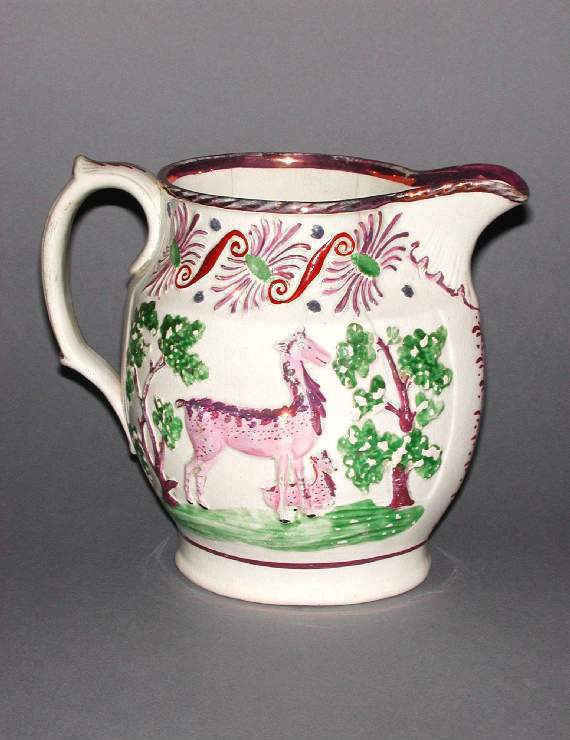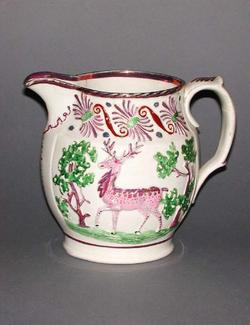Current Location: In storage
Titles
Stag jug
Maker(s)
Factory:
Unidentified factory
(Probably)
Entities
Categories
Description
White earthenware, moulded, glazed and painted with pink lustre and green and blue enamels.
Oval section, relief-moulded jug with a loop handle (with thumb-piece) and slight shoulder. The relief-moulded decorations, painted in pink lustre and green enamel, are: on one side, a relief-moulded image of a stag between two trees; on the other, two hinds with similar trees; and around the neck, a band of alternate flowers and scrolls, with small flowers painted in blue enamel. The rim has a rope moulding and is rimmed in pink lustre and there are stylised pink lustre designs running down the handle and under the lip. The underside is recessed and glazed.
Notes
History note: Bought from Mr Woolston of Hyde Park Corner, Cambridge on 1 July 1908 for 12/6d (twelve shillings and sixpence), by Dr J W L Glaisher, Trinity College, Cambridge.
Legal notes
Dr J.W.L. Glaisher Bequest, 1928
Measurements and weight
Depth: 11.5 cm
Height: 15.5 cm
Width: 17 cm
Acquisition and important dates
Method of acquisition: Bequeathed
(1928)
by
Glaisher, J. W. L., Dr
Dating
19th Century, Early
George IV
Circa
1810
CE
-
1825
CE
Note
English lustreware was commercially produced from c.1805 and popular throughout the first half of the 19th Century. Staffordshire potters were the first and largest producers, though similar wares were also made in other regions and pink lustreware is often particularly associated with Sunderland. Potters used minute amounts of gold to produce copper, gold, pink or purple lustre, depending on the type of clay, lustre formula, number of layers and firing temperature; platinum was used to mimic silver. Oval section moulded and lustred jugs were made by many Staffordshire potteries in the 1820s, and also in other areas, but factory markings are rare. Most lustreware was made for everyday use, with simple country-style decoration or designs commemorating popular events, royalty or other prominent people. Stags and hunting scenes were popular motifs.
Components of the work
Decoration
composed of
enamels
( green and blue)
lustre
( pink)
lead-glaze
Materials used in production
White earthenware
Techniques used in production
Moulding
: Moulded earthenware, glazed, lustred and painted with enamels
Inscription or legends present
- Text: No. 2809. Jug with raised design in purple lustre (stag & hind etc) b. in Cambridge, July 1, 1908. Came from Harston [?]
- Location: Underside of base
- Method of creation: Rectangular paper label handwritten in black ink
- Type: Label
References and bibliographic entries
Identification numbers
Accession number: C.1161-1928
Primary reference Number: 71433
Old object number: 2809
Stable URI
Audit data
Created: Saturday 6 August 2011
Updated: Tuesday 30 April 2024
Last processed: Tuesday 15 July 2025
Associated departments & institutions
Owner or interested party:
The Fitzwilliam Museum
Associated department:
Applied Arts





